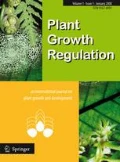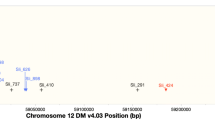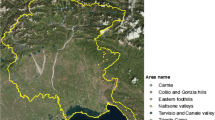Abstract
Gametoclonal variation that occurs in gametic cells in culture and is recovered in their regenerated derivatives has not been reported in potato (Solanum tuberosum L.). Based on a set of 24 differentiating phenotypic traits, canonical variates analysis genetically distinguished the androgenic (di)haploid (2n = 2x = 24) D4 from its tetraploid (2n = 4x = 48) anther-derived sibs and anther donor JTH/C-107. Nuclear microsatellite analysis over six polymorphic loci indicated that meiotic rearrangements and mutant alleles were primarily associated with the release of gametoclonal variation. The incidence of null alleles in D4 at the loci STACCAS3 and STM0031 was also indicative of mutations occurring within the priming sequence. Microsatellite results were supported by random amplified polymorphic DNA (RAPD) assays that characterized a total of 567 loci (bins) representing 4,258 amplified fragments. Sixty-five new RAPDs that were absent in the anther donor and in either of its parents, viz., S. phureja Juz. & Buk. IVP-35 and S. tuberosum cv. Kufri Jyoti were present in D4, indicating the occurrence of extensive recombinational events. The results have been discussed in the context of microsatellite null alleles providing the most conclusive evidence for gametoclonal variation.




Similar content being viewed by others
Abbreviations
- CVA:
-
Canonical variates analysis
- PCR:
-
Polymerase chain reaction
- RAPD:
-
Random amplified polymorphic DNA
- SSR:
-
Simple sequence repeat
- UPGMA:
-
Unweighted pair-group method arithmetic average
References
Bastiaanssen HJM, Ramanna MS, Sawor Z, Mincione A, Steen AVD, Jacobsen E (1996) Pollen markers for gene centromere mapping in diploid potato. Theor Appl Genet 93:1040–1047
Bentolila S, Hardy T, Guitton C, Freyssinet G (1992) Comparative genetic analyses of F2 plants and anther culture derived plants of maize. Genome 35:575–582
Callen DF, Thompson AD, Shen Y, Phillips HA, Richards RI, Mulley JC, Sutherland GR (1993) Incidence and origin of “null” alleles in the (AC)n microsatellite markers. Am J Hum Genet 52:922–927
Cappadocia M, Ramulu KS (1998) Anther culture in potato improvement. In: Khurana SMP, Chandra R, Upadhya M (eds) Comprehensive potato biotechnology. Malhotra Publishing House, New Delhi, pp 1–30
Chani E, Veilleux RE, Boluarte-Medina T (2000) Improved androgenesis of interspecific potato and efficiency of SSR markers to identify homozygous regenerants. Plant Cell Tissue Organ Cult 60:101–112
Chani E, Ashkenazi V, Hillel J, Veilleux RE (2002) Microsatellite marker analysis of an anther-derived potato family: skewed segregation and gene-centromere mapping. Genome 45:236–242
Doggramac-Altuntepe M, Peterson TS, Jauhar PP (2001) Anther culture derived regenerants of durum wheat and their cytological characterization. J Hered 92:56–64
Evans DA, Sharp WR, Medina-Filho HP (1984) Somaclonal and gametoclonal variation. Am J Bot 71:759–774
Finnie SJ, Forster BP, Chalmers KJ, Dyer AF, Waugh R, Powell W (1991) Genetic stability of microspore-derived doubled haploids of barley: a cytological, biochemical, and molecular study. Genome 34:923–928
Huang B (1996) Gametoclonal variation in crop improvement. In: Jain SM, Sopory SK, Veilleux RE (eds) In vitro haploid production in higher plants, vol 2. Kluwer, Dordrecht, pp 73–91
Javornik B, Bohanec B, Campion B (1998) Second cycle gynogenesis in onion, Allium cepa L., and genetic analysis of the plants. Plant Breed 117:275–278
Kinoshita T, Mori K (1998) Somaclonal selection of physiological mutants and several problems related to rice cell breeding. J Appl Genet 39:9–35
Kumar A (1994) Somaclonal variation. In: Bradshaw JE, Mackay GR (eds) Potato genetics. CAB International, Wallingford, pp 197–212
Link W, Dixkens C, Singh M, Schwall M, Melchinger AE (1995) Genetic diversity in European and Mediterranean faba bean germplasm revealed by RAPD markers. Theor Appl Genet 90:27–32
Logue SJ (1996) Genetic stability in microspore-derived doubled haploids. In: Jain SM, Sopory SK, Veilleux RE (eds) In vitro haploid production in higher plants, vol 2. Kluwer, Dordrecht, pp 1–51
Lough RC, Varrieur JM, Veilleux RE (2001) Selection inherent in monoploid derivation mechanisms for potato. Theor Appl Genet 103:178–184
Luo ZW, Zhang RM, Kearsey MJ (2004) Theoretical basis for genetic linkage analysis in autotetraploid species. Proc Natl Acad Sci USA 101:7040–7045
Meyer R, Salamini F, Uhrig H (1993) Isolation and characterization of potato diploid clones generating a high frequency of monohaploid or homozygous diploid androgenetic plants. Theor Appl Genet 85:905–912
Mifidabadi AJ, Jorabchi A, Shahrzad S, Mahmodi F (2001) New genotypes development of Populus euphratica Oliv. using gametoclonal variation. Silvae Genet 50:275–279
Munoz M, Cistue L, Castillo AM, Romagosa I, Valles MP (2004) A retrotransposon sequence is related to DNA instability in barley microspore culture. In: Vollmann J, Grausgruber H, Ruckenbauer P (eds) Genetic variation for plant breeding. EUCARPIA General Congress, Tulln, pp 223–225
Naik PS, Sarkar D, Gaur PC (1998) Yield components of potato microtubers: in vitro production and field performance. Ann Appl Biol 133:91–99
Raker C, Spooner DM (2002) The Chilean tetraploid cultivated potato, Solanum tuberosum, is distinct from the Andean populations; microsatellite data. Crop Sci 42:1451–1458
Redha A, Schmid JE, Buter B, Stamp P, Attia T (1998) Cytological investigation of R1 and R2-generations of spontaneously and colchicine induced diploid anther derived wheat plants. Cytologia 63:267–278
Rivard SR, Saba-El-Leil MK, Landry BS, Cappadocia M (1994) RFLP analyses and segregation of molecular markers in plants produced by in vitro anther culture, selfing, and reciprocal crosses of two lines of self-incompatible Solanum chacoense. Genome 37:775–783
Saghai-Maroof MA, Soliman KM, Jorgensen RA, Allard RW (1984) Ribosomal DNA spacer-length polymorphisms in barley: Mendelian inheritance, chromosomal locations, and population dynamics. Proc Natl Acad Sci USA 81:8014–8018
Sanguinetti CJ, Dias Neto E, Simpson AJG (1994) Rapid silver staining and recovery of PCR products separated on polyacrylamide gels. Biotechniques 17:915–919
Sarkar D, Pandey SK, Sud KC, Chanemougasoundharam A (2004) In vitro characterization of manganese toxicity in relation to phosphorus nutrition in potato (Solanum tuberosum L.). Plant Sci 167:977–986
Schweiger G (1990) Charakterisierung und RFLP-analyse spezifischer Genomkomponenten bei Solanum und ihr Einsatz zur Identifikation somatischer Hybride von S. tuberosum- Zuchtlinien. Dissertation, Eberhard Karls Universität Tübingen
Sharma S, Chanemougasoundharam A, Sarkar D, Pandey SK (2004) Carboxylic acids affect induction, development and quality of potato (Solanum tuberosum L.) microtubers grown in vitro from single-node explants. Plant Growth Regul 44:219–229
Sharma S, Sarkar D, Pandey SK (2010) Phenotypic characterization and nuclear microsatellite analysis reveal genomic changes and rearrangements underlying androgenesis in tetraploid potatoes (Solanum tuberosum L.). Euphytica 171:313–326
Sotirova V, Shtereva L, Zagorska N, Dimitrov B, Bogatsevska N (1999) Resistance responses of plants regenerated from tomato anther and somatic tissue cultures to Clavibacter michiganense subsp. michiganense. Israel J Plant Sci 47:237–243
Torjek O, Kiss E, Mazik-Tokei K, Hutvagner G, Silhavy D, Banfalvi Z, Kertesz Z, Pank J, Heszky L (2001) Comparative molecular analysis of winter wheat cultivars and their doubled haploid derivatives. Cereal Res Commun 29:41–48
Valdes AM, Slatkin M, Freimer NB (1993) Allele frequencies at microsatellite loci: the stepwise mutation model revisited. Genetics 133:737–749
Van de Peer Y, De Watcher R (1994) TREECON for Windows: a software package for the construction and drawing of evolutionary trees for the Microsoft Windows environment. Comput Applic Biosci 10:569–570
Veilleux RE (1998) Gametoclonal variation in crop plants. In: Jain SM, Brar DS, Ahloowalia BS (eds) Somaclonal variation and induced mutations in crop improvement. Kluwer, Dordrecht, pp 123–133
Veilleux RE, Shen LY, Paz MM (1995) Analysis of the genetic composition of anther-derived potato by random amplified polymorphic DNA and simple sequence repeats. Genome 38:1153–1162
Yamagishi M (2002) Gametoclonal variation in anther culture-derived rice plants. II Segregation of mutated plants at the first progeny generation. J Genet Breed 56:303–308
Yoshida S, Watanabe K, Fujino M (1998) Non-random gametoclonal variation in rice regenerants from callus subcultured for a prolonged period under high osmotic stress. Euphytica 104:87–94
Zagorska NA, Shtereva LA, Kruleva MM, Sotirova VG, Baralieva DL, Dimitrov BD (2004) Induced androgenesis in tomato (Lycopersicon esculentum Mill.). III Characterization of the regenerants. Plant Cell Rep 22:449–456
Acknowledgments
We thank Sheesh Ram Thakur and Ram Dayal for field management, and Indian Council of Agricultural Research (ICAR), New Delhi for financial support in the form of an ad-hoc research project (F. No. 8-45/2004-Hort. II). Comments and suggestions on the manuscript from the Editor/an anonymous reviewer are gratefully acknowledged.
Author information
Authors and Affiliations
Corresponding author
Electronic supplementary material
Below is the link to the electronic supplementary material.
Rights and permissions
About this article
Cite this article
Sarkar, D., Sharma, S., Chandel, P. et al. Evidence for gametoclonal variation in potato (Solanum tuberosum L.). Plant Growth Regul 61, 109–117 (2010). https://doi.org/10.1007/s10725-010-9455-z
Received:
Accepted:
Published:
Issue Date:
DOI: https://doi.org/10.1007/s10725-010-9455-z




